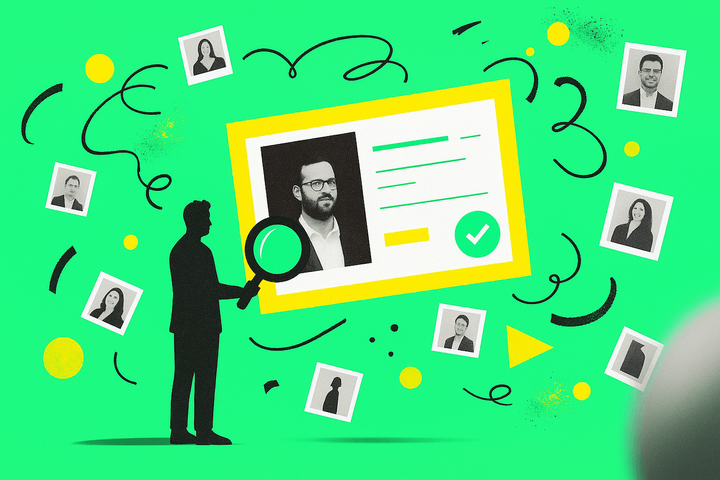Introducing Directory Intelligence: Getting The Most Out Of Your Directory Data
Directory intelligence is a new concept in the digital workplace that focuses on analyzing and improving your directory data to enable modern employee experiences.

Today, we'd like to introduce you to a new concept that is shaping the future of the digital workplace.
It's a new category we're calling directory intelligence.
There's 3 key pillars to directory intelligence, which we'll explore in a minute.
But first:
Earthworms 🐛🐛
When was the last time you thought about earthworms?
They're in your garden right now doing a lot of hard work for you, aerating your flower beds and enriching your vegetable patch.
On a global scale, earthworms give life to soil and allow trees and crops to grow, making it possible for us to live on the planet.
They're pretty important little creatures.
In fact, earthworms have been ranked as the #1 most influential species in history — above humans at #6!
In his final manuscript, Charles Darwin wrote affectionately of the earthworms he spent 39 years studying:
"It may be doubted if there are any other animals which have played such an important part in the history of the world as these lowly organized creatures."
So what do these wigglers have to do with the future of the digital workplace?
Well, besides ensuring survival of the human race, nothing.
But the point is that just beneath the surface of everyday life exists complex, hidden worlds that go largely unnoticed by most people, yet are very important to us.
Things like electricity ⚡, running water 💧, concrete 🧱, vaccinations 💉, air travel 🛫, the internet 🌐, toilets 🚽, and thousands of other things.
Back to your workplace.
Right now, there's an important part of your digital workplace that lives behind-the-scenes, neglected.
Yet it's used in some way by every person and every app in your company.
Like the innovations above, it's an important piece of infrastructure, but unlike the above it gets very little care.
Ignored and overlooked, it's the forlorn second cousin of your organization's most beloved workplace tools.
We're talking about your company's directory data.
Directory data is the employee profile information and other metadata that is stored in various "employee databases" in your organization.
In Microsoft 365, that would include Azure Active Directory (Azure AD) and your SharePoint user profile database. If you're not using Microsoft 365 then your directory data might come from a directory-as-a-service provider like G Suite, Okta, or JumpCloud, or it may reside in an HR system like ADP or Workday.

Now, it’s not every day that one gets to define a new software category.
But today is such a day, and we’re excited to share with you this idea that we've been talking about internally for a few months now.
Welcome to the world of directory intelligence.
What is directory intelligence?
Directory intelligence is about using your directory data in new and better ways.
It's about analyzing and improving the quality of your directory data so you can use it to make your digital workplace more efficient, and create better employee experiences.
Here's a formal definition:
Directory intelligence is the strategies and technologies for analyzing and improving your company’s directory data to create a more efficient digital workplace.
There are three key elements to directory intelligence:
- Analyzing and auditing your directory data
- Improving the quality of your directory data
- Building better employee experiences with directory data
Let's explore these 3 points.
1. Analyzing your directory data for quality issues
Directory data in most organizations is horribly inaccurate and out of date.
In the hundreds of employee directory implementations we've done, we've learned that most companies are unaware of how bad their directory data really is, or that it's even a problem.
In the case of our customers, it's typically after starting a trial of OneDirectory (our enterprise employee directory software) that they realize the extent of their Active Directory's quality issues.
Things like:
- Missing photos, missing job titles, office and department fields not filled in
- Phone numbers outdated and incorrectly formatted
- Duplicate accounts
- Spelling mistakes
- Colleagues in the same office location with different work addresses
- Bad quality photos, or photos with their dog 🧔🐶
- Org chart issues like missing managers, broken reporting lines, orphaned accounts, and circular references
- No birthdays, hire dates, skills, interests, or bio
And dozens of other quality issues that may seem unimportant at first, but like our squirmy garden friends, are perhaps more important than you realize.
We wondered...
If directory data is so important, why aren't companies putting more effort into improving it?
The reason is simple: it's just a lot of effort.
Fixing directory data is a disheartening, manual cleanup operation that can take weeks, even months. It's a thankless task that's never truly finished.
Sometimes - through a combination of manual updates in Azure AD, rummaging through SharePoint's profile database, fiddling with PowerShell scripts, and building email campaigns for staff to update their own employee profiles - companies emerge semi-victorious.
But most of the time they don't even try because it's too much work. So they leave their directory data outside in the rain where it becomes soggy and unusable.
What if we had tools that could help us?
Intelligent tools that could analyze and audit the state of our directories, and tell us what needs fixing.
Maybe then it wouldn't be so difficult to keep our directory data up to date.
For us, this is where directory intelligence begins; with the strategies and tools that help us analyze the health of our directories.
At OneDirectory, we're working on such tools (of course we are 😉).
Starting with Directory Health, which shows you what's missing in your employee profiles so you know what needs fixing in Active Directory/Azure AD.
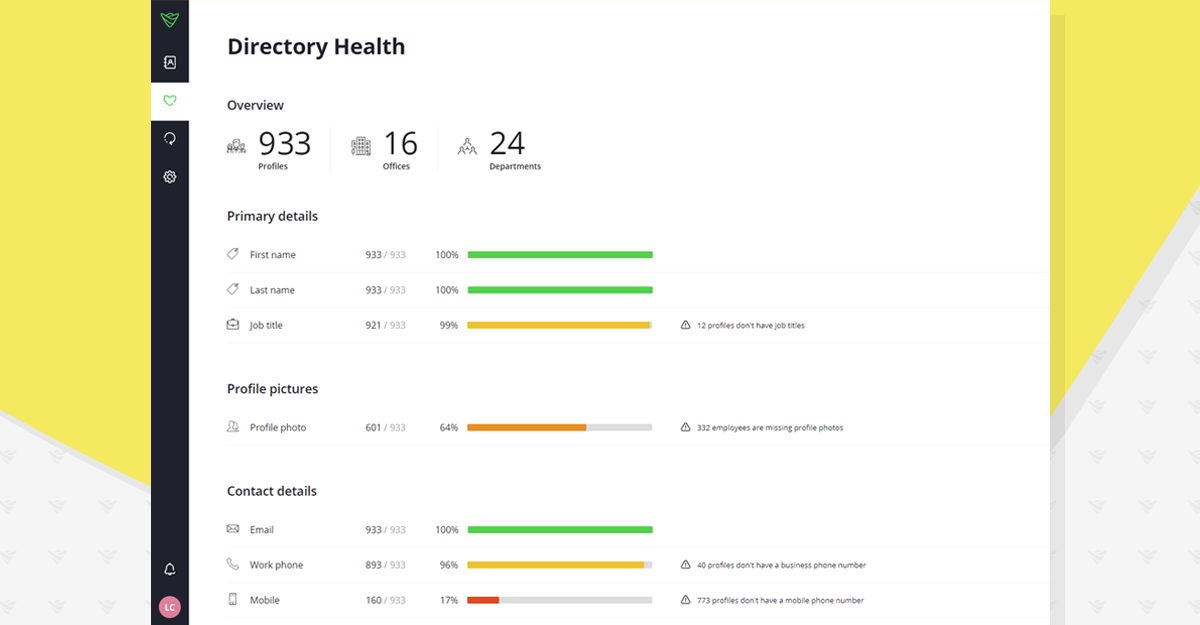
Directory Health is already helping our customers improve the quality of their directories, but as we've seen above, "missing information" is just one quality factor and is only the tip of the iceberg. Properly auditing your directory data requires potentially hundreds of rules and thousands (millions?) of data points to be checked and monitored.
But that is why it's called directory intelligence.
The idea is to use smart code and AI to analyze and fix directory data at scale, so your organization can get more benefit out of it.
Directory intelligence gives you the power to understand exactly what's happening in your directory data.
To analyze it, monitor it, and maybe even get recommended suggestions on how to improve it.
Because of course, analyzing your directory isn't very useful if you're not using it to improve your directory.
This is where the next important piece of directory intelligence fits in: fixing your directory data.
2. Improving the quality of your directory data so your digital tools work better
You're an astronaut. 👨🚀
You're in space.
The Shuttle's Orbital Maneuvering System has just malfunctioned and you have 12 minutes to fix it or you and your team will die.
Lucky you're an engineer, you've trained for this.
You grab your toolbox and scurry outside the spacecraft where you notice a bunch of wires that are hanging loose. Must've been a piece of space debris, or a flock of pigeons.
"There are no pigeons in space," you tell yourself as you realize the extent of the damage. With no idea how to reconnect the wires, you grab the instruction manual.
Unfortunately, you discover the manual is in Russian, and you don't speak Russian.
They sent the wrong manual.
Why they put a Russian manual in your Jamaican spacecraft, you can't seem to figure out.
Maybe it was Boris in Engineering. He got you real good last time with that fish prank. But this is different. And Boris quit 5 months ago so it definitely wasn't Boris.
Time is running out, the ship is spinning out of control, you have a handful of wires and the manual is gobbledygook.
You almost give up hope when suddenly you remember the iPhone app your daughter installed for you. The translation thingy.
You grab your iPhone, translate the Russian, connect the wires, and save the day.
Later, you realize it wasn't a Russian manual, you just had it upside-down. And the "translation app" was just an image rotater.
The moral of this curious space story is that you might have all the right tools, but with bad information, those tools can be useless.
This is the state of your digital workplace today.
Right now, you have a range of collaboration tools that can help you answer any question or find anyone and anything you need to get your work done: your intranet, messaging tools, social apps, knowledge apps, spreadsheets, employee directories, org charts, and search boxes everywhere.
You can practically hear your workplace humming.
Still, even with all this power, you aren't able to answer simple questions about the people or teams you work with every day. Answers you need to achieve a task or to engage with your colleagues.
🙋♂️ "Who is Maggie's assistant?"
📞 "What's Debbie's extension?"
👀 "Who worked on that project two years ago?"
👴🏻 "Was it Bill or Bob I met in Accounting last week?"
🏢 "How big is our Marketing department?"
👨💻 "Who can install the printer for me?"
📅 "Is Jasper in the office today?"
👩⚕️ "How many other doctors work in this wing?"
👨🏾💼 "Any other sales people in this office?"
🔖 "What was Sam's last name again?"
🎂 "Who has birthdays this week?"
💂🏻♂️ "Who reports to me?"
🚴♂️ "Anyone in this office into cycling?"
🌎 "Where is Jason working from?"
🧔 "Who here has done marketing automation before?"
🇿🇦 "What's the number for the Cape Town office?"
👩🏽🦳 "What does Amy's manager look like?"
🐦 "Anyone else on my team have a Twitter account?"
🤔 "Actually, who is my boss's boss's boss?"
...
Why isn't this information easily accessible to you?
It's not the tools. You've got the right tools.
The limitation is your bad quality directory data.
Directory intelligence enables you to use your workplace tools the way they were meant to be used.
Clear profile photos everywhere, accurate contact numbers, an org chart that's always up to date, employee skills that are easily accessible, and more.
Directory intelligence allows Outlook, Microsoft Teams, SharePoint, and all your collaboration and communication apps to work smoothly, as they were intended.
Currently, keeping your directory data up to date is a manual process, one in which you edit profiles one by one.

If you're an admin, you can also create a custom script to do bulk updates to multiple profiles in Microsoft 365 at once.
But.
What we really need is smart tools that do this for us.
Smart tools that:
- Help your employees update their own profiles way easier than they can today (the current experience, at least in Microsoft 365, is terrible).
- Help your IT admins clean up your organization's directory data "in bulk" with better user interfaces for enabling directory corrections at scale.
- Help your organization keep its directory data updated; by gathering and filling in missing information automatically, and by correcting the dozens of data issues affecting your directory.
All of this is great... but what else could we do?
What new workplace capabilities does directory intelligence allow us to dream up?
This is where we get to part 3, arguably the most exciting ingredient in the directory intelligence cookbook.
Part 3 gives us a glimpse of the future of work.
3. Building better employee experiences with directory data
What work will be like in 10 years time, let alone in say 50 years time, is anybody's guess.
What we do know is that your directory data - your organization's employee profile information - will be a part of it.
Well, as long as humans are still running the show.
For the past decade or so, workplaces around the world have been caught up in digital transformation initiatives. Becoming "more digital."
Now those digital workplaces are quickly evolving into intelligent workplaces.
Not just due to the COVID-effect (although that played a huge role) but because of evolution and necessity; smart workplaces are inevitable.
That's happening right now.
Today's modern, intelligent workplace is about automation, doing more with your data, and using AI to make work more efficient.
It's also about creating better employee experiences.
And that's where this new concept of directory intelligence fits in to the intelligent workplace.
Directory intelligence enables better employee experiences by using directory data in new and smarter ways.
One example is the modern employee directory.
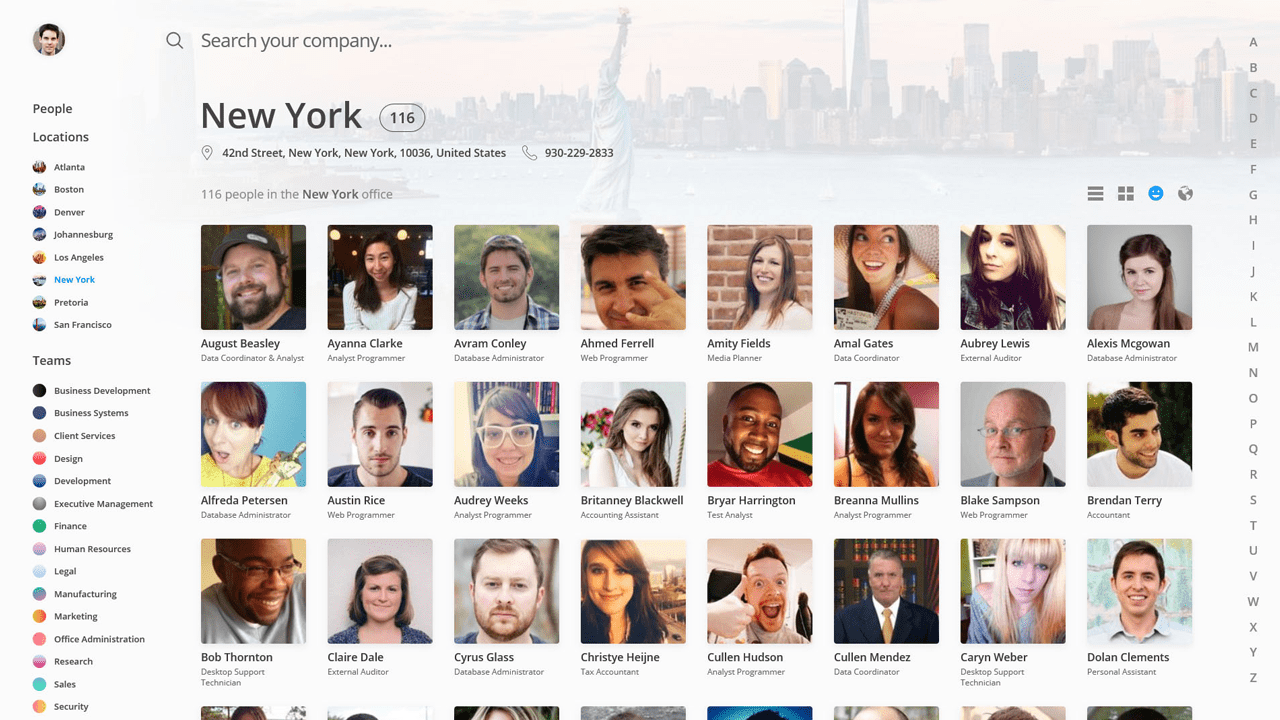
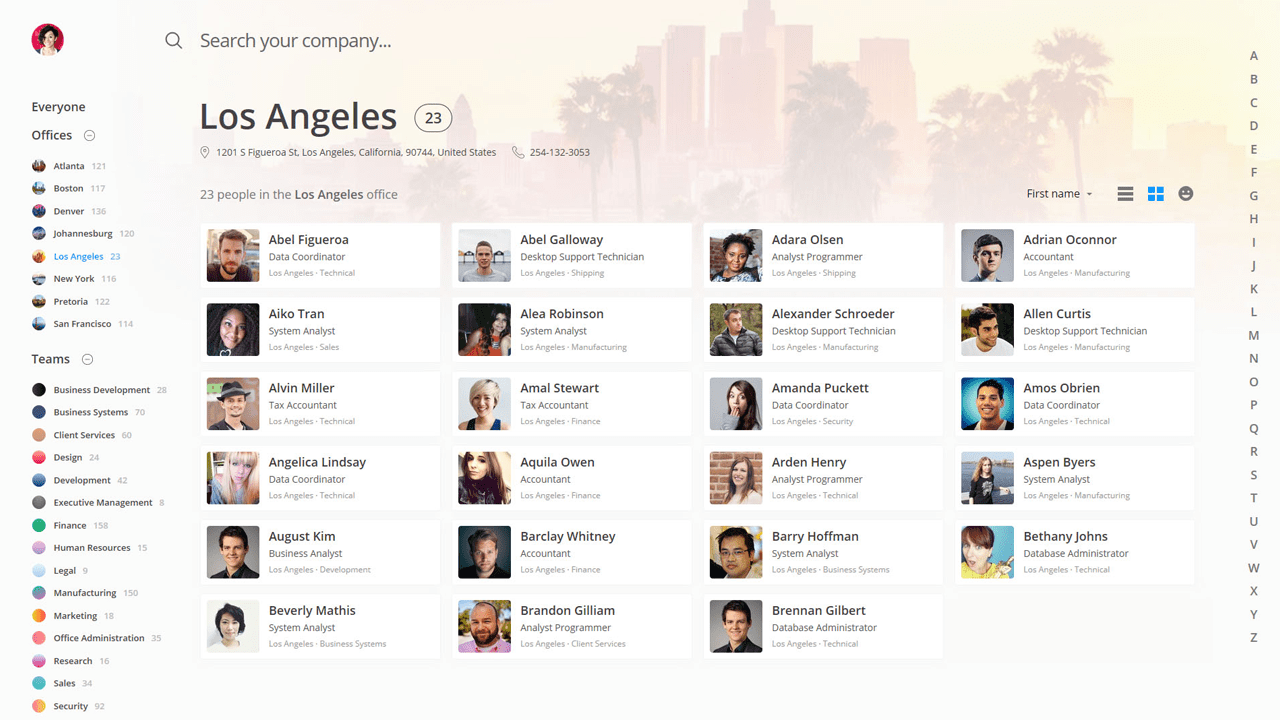
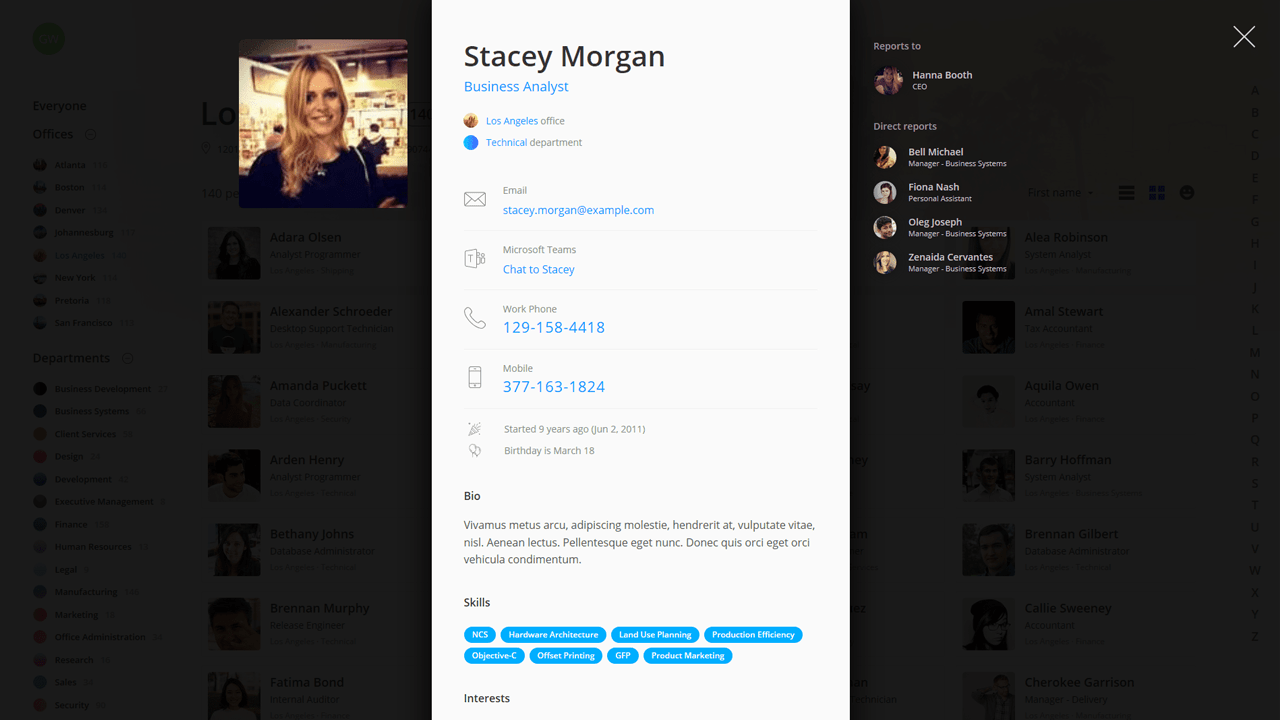
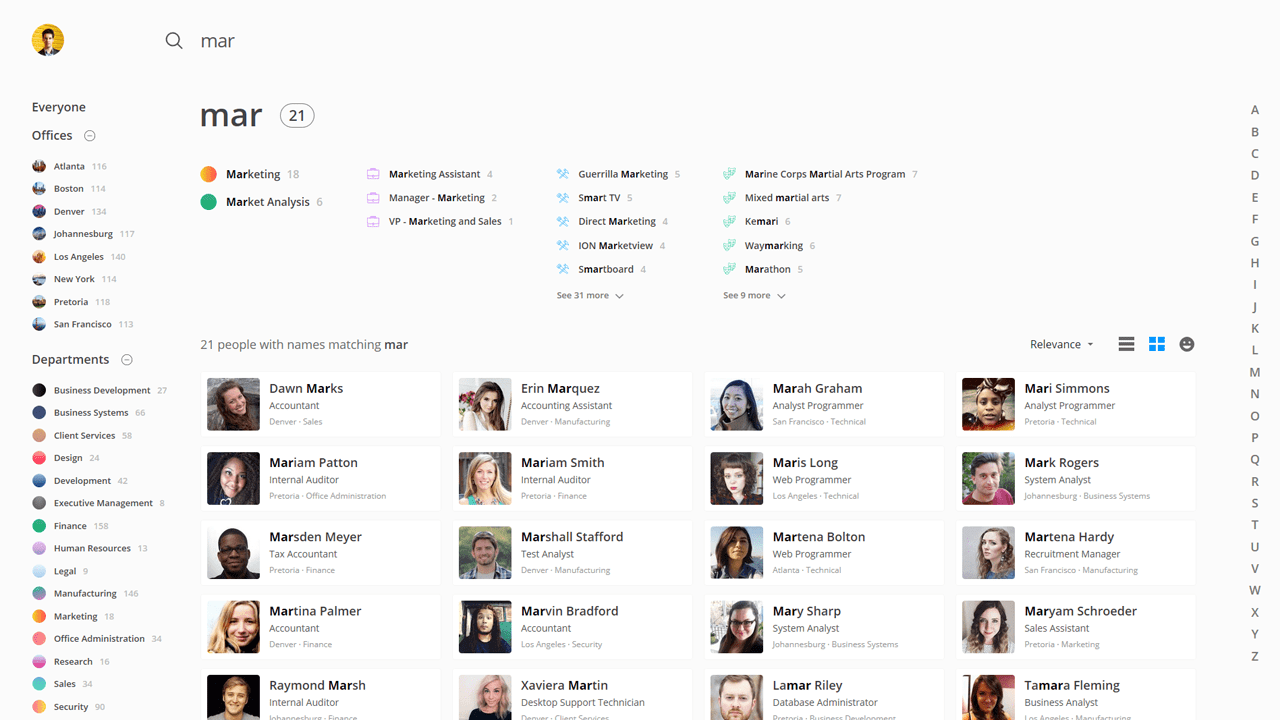
Employee directories have been around forever in one form or another, but as organizations have started to focus a lot more on the employee experience in recent years, the humble corporate directory has begun to go through a period of modernization.
And it's proving to be a pretty useful tool in the intelligent workplace.
It's now possible to find colleagues, browse faces, start chats, search for skills, understand the org chart, see your company structure, and learn more about the people you work with, far easier than you could merely a decade ago.
Just ask us. We build employee directories.
In fact, we're employee directory nerds. 🤓
We wake up thinking about employee directories, and we go to bed thinking about barbecues and employee directories.
At OneDirectory, we've seen first hand the impact a modern corporate directory can have in the workplace.
The year was 2018.
We had been toiling away for seven years helping companies launch employee directory solutions in their SharePoint intranets.
Our directory product was running at Fortune 500’s, NFL teams, secret investment companies, hospitals, banks, schools, and organizations in almost every industry except goat rentals and mobile weddings.
(Turns out you actually can rent a herd of goats, who knew. 🐐🐐)
Although useful, our staff directory app was being utilized as a glorified contact list rather than a real collaboration tool, and the digital workplace was changing.
Our customers needed better tools to keep their employees connected and engaged.
We began to wonder...
In this new "digital" workplace, where do I go to find and connect with my coworkers? It's easy in real life... in the office. But now everything's cloud, social, mobile, connected. Where is the "map" of my company?
That tool just didn't exist.
Which, again, got us thinking.
Who cleans up all the goat poop? 💩
And what does the employee directory of the future look like?
To answer the second question, we would take everything we knew about employee directories, strip out the unnecessary junk, rethink people search, make it cloud, make it fast, make it pretty, and make it feel "natural."
And so we set out on a quest to build an employee directory experience unlike anything before it.
We imagined people flowing through their company digitally, easier than walking through their physical offices.
We dreamt of a people-centric tool that's at the center of your digital workplace, not just a little component buried somewhere in your intranet.
We fantasized about killing lazy solutions like advanced search, page loads, query builders, pagination, and the endless filters and options that got in the way of simply connecting with people at work.
OneDirectory showed us the kinds of employee experiences that are possible with directory data.
People ♥ great employee experiences.
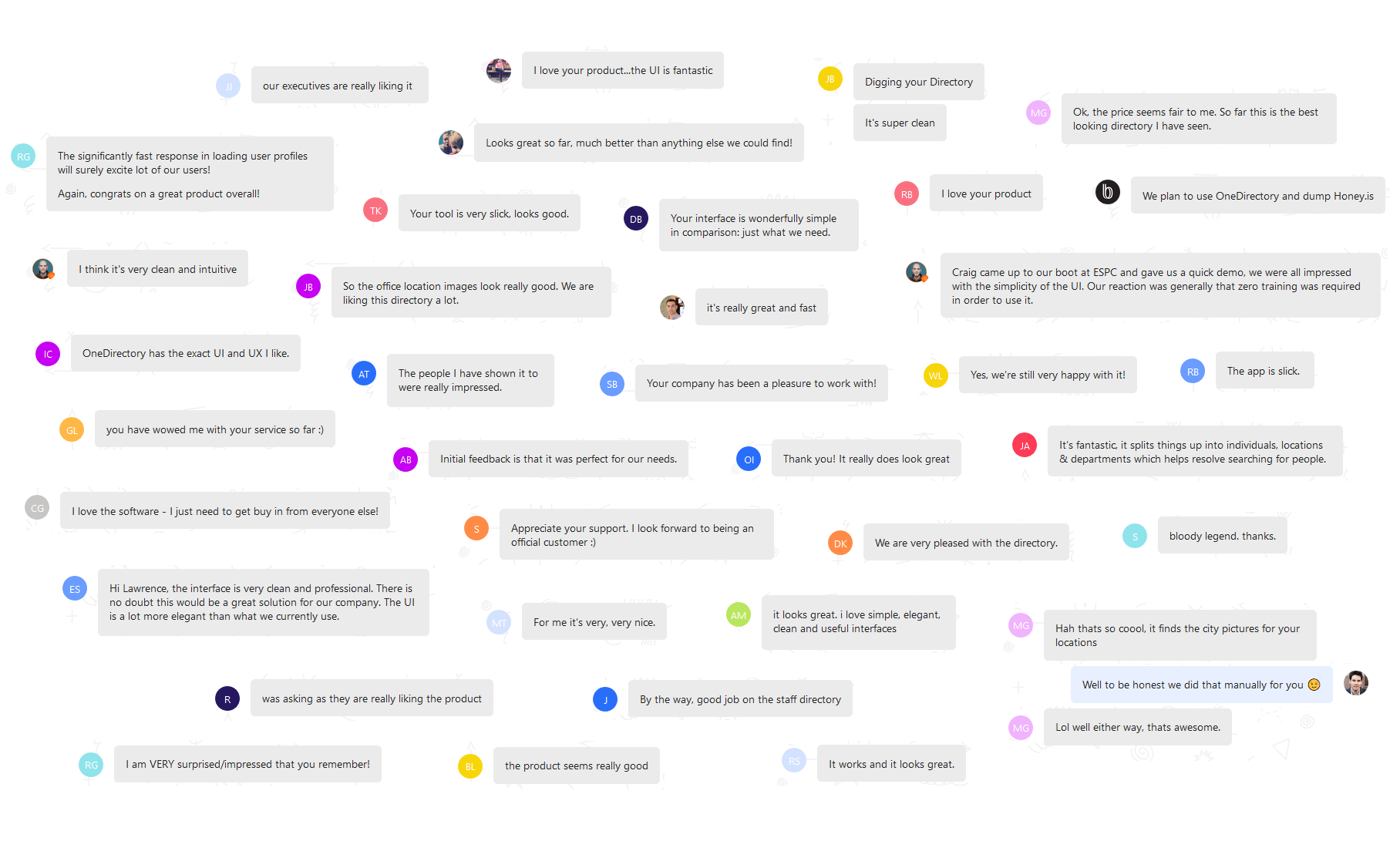
But enough about us and employee directories.
Let's imagine some of the other experiences that could be built with directory data.
With better quality directory data. ✨
Imagine the future of employee onboarding, where new employee info needs only to be captured once, before it's synced to every employee database instantly, across HR and IT. Yes we have the tools now, but without accurate data it's not that valuable.
What about the HR systems of the future, which don't just "have fields" for important-yet-overlooked things like emergency contact, medical info, diet preferences, home address, personality type; but rather, those fields are actually filled in and kept up to date.
The skills directory of the future will help you find coworkers with the knowledge you need, for real. Today's workplace tools already have skills "fields," but nobody fills them in; imagine the tools we could build if we had accurate skills and responsibilities data for every employee.
Directory intelligence can help enable diversity and gender-inclusivity with pronouns, nicknames, languages, and photos being readily available across every workplace app. There's more to someone's identity than first name + last name.
What about the social experiences we could build?
Interests, bios, birthdays, work anniversaries, social media links, work history, college, hometown, locations — data you could use to make your digital workplace more social and engaging (or dare we say, "fun.")
Imagine the kinds of tools we could create for employee wellness and employee recognition, if our directory data was up to date.
The tools we could build for travel & expense, leave management, meetings, and shifts.
And the engaging solutions we could give to our frontline workers, who are often overlooked and excluded from our modern digital workplaces because they don't have a desk or a laptop.
Think of the workforce analytics tools we could build with better directory data to help HR teams with recruitment, performance, training, and compensation.
And the organizational planning tools we could create using accurate org chart data.
Then of course there's the VR workplaces of the future... 🥽
Where to from here?
In this post we introduced directory intelligence as a new category, and we shared some of our thoughts on how it can be used and where we think it's headed.
The takeaway?
By using directory data more effectively, we can help transform our digital workplaces into more intelligent workplaces.
In the future we imagine there'll be many more tools available to help you achieve directory intelligence, and we're excited to see what solutions our industry comes up with.
The future of work awaits.
At OneDirectory, our mission is to help organizations improve their digital workplaces through directory intelligence.
Subscribe below or follow us on LinkedIn to keep updated as we build the directory intelligence category.


